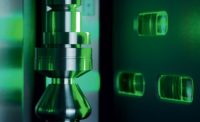Optical metrology is a crucial tool used in industrial automation to increase productivity and quality levels via 100% inspection rates. Thanks to the latest leaps towards higher resolution and frame rates of image sensors accompanied by mature high-bandwidth camera interfaces like USB3.0, optical metrology today allows for very fast analysis of 2-D and 3-D objects with unprecedented accuracy. This article provides considerations and reasoning on how to select the right key system components, especially cameras, for different metrology applications.
System Parameters and Accuracy in Optical Metrology
The designs of optical metrology systems vary widely, depending on the application. However, lens, image sensor, and camera play the key role in all classic systems. Each component influences the performance of the system in quantitative and qualitative aspects. Quantitative parameters are the measurement accuracy in the 2-D image plane and in the third dimension, the depth, as well as the time required to capture and measure an object. Furthermore, one needs to take into account whether the target object is stationary or in motion (e.g. on a conveyor belt or handled by a robot). A qualitative parameter is the reliability of a measurement system. Despite varying environmental conditions, like temperature and lighting, measurement results shall be consistent and reproducible. Also the failure rate of measurement operations itself, e.g. due to issues in camera electronics or software, is critical.
Regarding image sensor resolution, it is obvious that the number of pixels is directly proportional to the spatial resolution and accurate representation of the object. Unless one can ensure that the object and the camera are absolutely still during the exposure time of the sensor, a global shutter sensor is mandatory so that all pixels are captured and read out at the same time after the exposure is finished. With global shutter technology, no distortion is introduced by movements during the exposure. The standard approach of classic industrial camera design is to take a good sensor with CCD or CMOS global shutter technology, add various image enhancement features and capture modes and implement the camera in a low-cost design.
Camera selection is often based on resolution, frame rate, minimum exposure time, and price criteria, which works well for applications in general inspection and presence detection like food and print quality verification or normal factory automation. New innovations in image sensor designs and data interfaces are enabling camera manufacturers to produce cameras with increased resolutions coupled with higher frame rates. These innovations are increasing the range of applications that can leverage the new technologies for more precise inspection results.
Applications of Optical Metrology and Resulting Requirements
In 2-D geometrical metrology, a single camera is mounted orthogonally to the surface that shall be captured. When it comes to the analysis of the dimension, e.g., of flat metal sheets after cutting, milling, drilling and further processing steps, the sheets are moving on a conveyor. On top of the belt, a metrology camera is mounted and a typical range for the intended accuracy is 0.1mm. In such scenarios, the production output is often limited by the inspection capacities rather than by the production machines itself. Thus, cameras should be able to capture and measure the objects when they are moving at high speed (e.g. 2 meters per second).
This requires the camera to be very sensitive in order to allow for short exposure times. And since multiple objects per second are passing by the camera, a high frame rate needs to be delivered to the processing unit. Thus, a camera interface with high bandwidth is required. CameraLink used to be the industry standard before USB3.0 became common in consumer and industrial PCs. While USB3.0 is considered to be widespread and mature, the careful design of the camera chipset, the camera firmware, image buffers inside the camera, the software driver, as well as the selection of the host chipset are crucial to make sure that all frames that are captured by the camera are actually delivered and retained by the PC; otherwise, parts may slip through the inspection process. This is a core aspect of the “qualitative performance” parameters of a metrology system mentioned above.
Zero frame loss is critical when moving objects are measured by several cameras in order to obtain a 3-D model. For a correct 3-D representation, all cameras need to capture an image of the object at the same point in time. This can be accomplished via external trigger signals linked to the general purpose I/O port of the industrial cameras. Even more critical, all frames from up to four cameras have to be delivered reliably to a single host PC where all images are then combined. If a frame from just one camera is lost, the whole measurement operation will fail.
Beyond a reliable video and control interface, metrology sets major requirements on the image quality of a camera. The advantages of larger sensor resolutions of the latest CCD and global shutter CMOS image sensors come with several challenges since no component is perfect. Often these sensors come with clusters of defective pixels. The correction of these defects is done in the manufacturing process by interpolating between the good pixels in the surrounding of the defects. Since in metrology sharp edges of objects need to be detected and measured, large clusters of defect pixels reduce the consistently achievable accuracy. Most high-end camera manufacturers grade incoming sensors and reserve the best devices with few defective pixels for cameras that go into metrology applications.
Another challenge of high resolution sensors and a major differentiator is the quality of the sensor tap-balancing. High resolution CCD sensors are divided in taps in order to allow for a faster readout. However, each tap has its own processing pipeline with analog-digital conversion and amplifiers. Again, each of these components is unique, which usually results in different levels of brightness between the 2 or even 4 taps. The differences in brightness lead to artificial edges in the image and can mislead measurement algorithms.
The balancing of the taps is done in the FPGA of the camera and requires the calibration of numerous parameters during manufacturing of the camera. Theses parameters depend on exposure time, gain and sensor temperature. Only with an elaborate calibration method can cameras deliver optimal image quality with uniformity and linearity under most operation conditions.
To conclude, in metrology systems for industrial automation and quality inspection higher camera resolution increases accuracy, high sensitivity allows for faster travel of the inspected objects and faster frame rates increase the throughput. The latest sensor technologies and interface standards allow metrology systems to meet these expectations. Aside from these improvements, the real differentiating factors for metrology cameras are the image quality, mechanical stability and reliability of the sensors, the read-out electronics, the camera interface, and software drivers. These are some of the critical aspects to be considered when it comes to the selection of system components for optical metrology applications. Most of them are not covered on datasheets and price lists but need the involvement of a trusted expert in the field so that the right components are selected to meet the application requirements.






